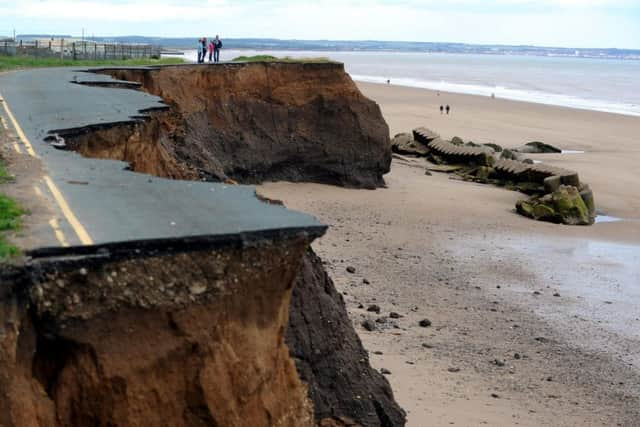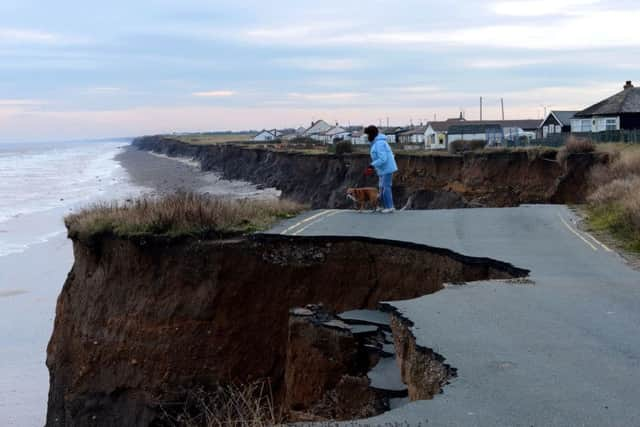Yorkshire’s clifftop homes need saving from waves of destruction causing coastal erosion - Andrew Vine
Any of us who have worked all our lives to be able to afford a place of our own would shudder at the prospect of it being destroyed. Yet for some residents of the Holderness coastline that is crumbling faster than anywhere else in northern Europe, that is the most likely outcome over the coming 12 months.
Advertisement
Hide AdAdvertisement
Hide AdUnsaleable and uninsurable, the homes on Skipsea’s clifftop are doomed, as many others along the 40 miles of our coastline between Bridlington and Spurn have been before them. Generations of householders on the Yorkshire coast have known the heartache that their counterparts in Skipsea are going through now, having to pack up and move out before their homes are demolished to prevent them crashing to the beach below.


But the pace of this destruction appears to be accelerating, with 30ft of land disappearing last year. Which begs the question of what the Government intends to do about addressing a problem of coastal erosion that doesn’t just go back centuries, but millennia. Geologists have calculated that during the Roman occupation of Britain, the coastline was three-and-a-half miles farther out to sea than it is now. And more than a century ago, the founding curator of Hull Municipal Museum, Thomas Sheppard, wrote a book, The Lost Towns of the Yorkshire Coast, setting out a roll call of more than 20 communities along the Holderness coast wiped off the map by erosion.
There is no trace of these vanished places of which Sheppard found some record. Only the ancient names remain, among them Colden Parva, Owthorne by Sisterkirk and Turmarr. All were consumed by the sea.
Advertisement
Hide AdAdvertisement
Hide AdAnd foot by foot, that is what is happening in Skipsea and other villages perched on the edge of the soft clay cliffs that are under assault from both the sea and sky. It’s not just the relentless tides scouring the cliffs away. The increasingly heavy rainfall that we are getting is having a destructive effect too, as the clay becomes saturated and then falls away when it can no longer support its own weight.


Yet the people of Holderness – and the local authorities – are being left on their own to cope, which is entirely wrong and has to change. The plea by East Riding of Yorkshire Council for Government funding because it is running out of money to demolish buildings at risk deserves to be heeded.
But the Government needs to go much farther. In a typically glib response, the Department for the Environment, Food and Rural Affairs brushed off the issue, saying it was spending £1.2bn to prevent coastal flooding.
Sorry, but this isn’t an issue about flooding. It’s about the loss of people’s homes and livelihoods. The vast swathes of land being lost don’t only have homes on them, but holiday parks and farms as well. Nor is this just an issue for the people of Skipsea, or for the council doing all it can to help them. This is a national problem that cries out for a properly co-ordinated central strategy and the funding to back it up.
Advertisement
Hide AdAdvertisement
Hide AdFor as long as I can remember, there has never been a joined-up approach to dealing with coastal erosion, led by Government and working closely with local authorities in affected areas. Councils have been left to react to immediate problems, such as buildings at risk or footpaths that are no longer safe to walk, and the issue simply doesn’t make it onto the radar of ministers.
The bigger places – like Hornsea and Withernsea, guarded by their concrete sea defences – have been protected, but in most cases the villages in between, like Skipsea, can only watch as the cliffs are worn away. Realistically, it probably isn’t possible to defend a 40-mile stretch of coastline, but that doesn’t mean the current approach of Government – which is to do nothing – can be justified in any way.
It is surely time for a full-scale study of the whole issue of coastal erosion, and the options for dealing with it, with the concerns and welfare of residents at its heart. Addressing climate change will need to be part of that, because rising sea levels and increased rainfall are critical threats to the cliffs of Holderness, but so must a plan for mitigating, or at least managing, the coastline’s destruction.
Advertisement
Hide AdAdvertisement
Hide AdAre there lessons to be learned from other countries in safeguarding coastal communities? The Government ought to be asking itself that question. But above all else, it needs to wake up to the whole issue. The occupants of clifftop homes in Holderness may currently face the worst plight, but erosion threatens many other places on England’s east coast as well. Abandoning all their residents have worked for to the waves is simply not an option.